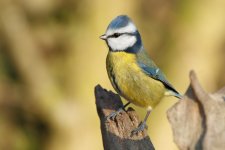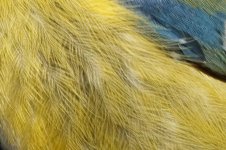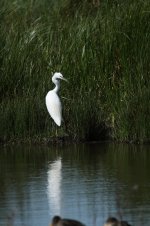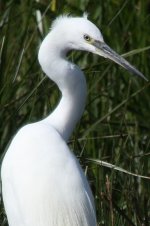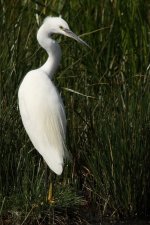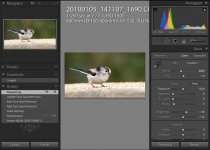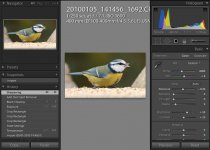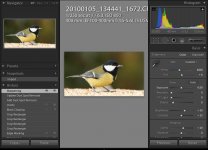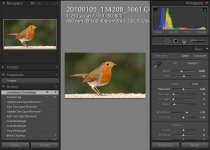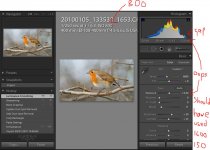I think it takes serveral things to combine together if you want that fine feather detail. Here are some thoughts, in no particular order....
- Fill the frame as much as you can. Get closer. No, closer.
- If you can't get close then get longer glass. That doesn't necessarily mean adding a teleconverter, because you then lose a stop of light and that may bring other challenges.
- Low ISO = low noise = low NR = higher sharpness. Find good light.
- Contrasty light coming in from the side will increase microcontrast and improve perceived sharpness. Flat, dull light will mean flat, dull images. Sure, you can tweak them, but you can't magic up shadows and highlights where none exist in the first place. A catchlight in the eye is always a big plus too.
- Lens focus must be mm perfect. If you view at 100% you will find the DOF to be very small. If you shoot hand held or you focus on the eye and the bird moves, or you do, it could lose you the shot. If your body has AF microadjustment then confirm your AF is optimised. If you have a tripod and a docile subject then you might even try Live View and manual focus at 10X, or Live AF if your body supports it - I see you have a 50D, so these options are available to you.
- Naturally you don't want camera shake, so a
good tripod and head is best, but IS will help and a high shutter speed is always nice. But a high shutter speed might require a wide open aperture and/or a high ISO, so a tripod is the better solution.
- Subject blur should not be discounted, so a high shutter speed is still useful. or flash, but again you will need good light for best results, whether supplied by nature or batteries.
- Skilled post processing can help too, to deal with noise and sharpening the subject and background independently. Sharpening after downsizing should be the final post processing step, and should be tailored to the output medium (screen or print) and final size.
So a few of those things are in conflict - you want to stop down for lens sharpness and DOF, but not so much that you get diffraction softening, but you also want a decent shutter speed to avoid shake and blur, but you want to keep the ISO low to reduce noise. The best solutions to that lot is good light, a tripod, and filling the frame as much as you can. The more magnification you achieve (larger the sbject captured at the sensor) at the point of capture the more detail you will have and the less cropping and/or magnification you will need to apply later. You'll also find that noise will be less significant in relation to the size of the details captured.
I thought of something else but have forgotten it again. I'll update when I remember.
EDIT : I've remembered the other point - When you shrink an image down to web size it is simply not possible to retain the detail that you originally captured. The pixel density of a typical monitor - probably between 100-132 pixels per inch - can not contain enough detail for close scrutiny. Instead of producing, for example, an 800x533 image for viewing from 12" it would be better to produce a 1600x1067 image for viewing from 24". That way you retain far more detail in the image and those with sharp eyesight will be able to see it.
EDIT 2 : And another one - Shoot raw and expose to the right. Then sort out the look of the thing in post. e.g. If you are shooting at, for example, 1/500, f/5.6, 400 ISO for a "correct" exposure, but still have a large gap on the right of the histogram, you will be better off raising the ISO to 800 for the capture, and then pulling the exposure down by a stop in post. Heck, if you have enough room to go up to 1600 ISO then do it. You will get more shadow detail and lower noise, once you pull things back down. Use the histogram, look for blinkies, ETTR. Unless you have a 1 series then don't use intermediate ISOs. Stick to 100, 200, 400, 800 etc..
Here is a shot from a couple of days ago. It is nothing special, but serves as an example of the benefits of (mostly) filling the frame. It was shot hand held with my 7D and 100-400 zoom lens. Despite my efforts to focus on the eye (or did I just aim for the body?) it looks like I just missed it, but the feather detail captured in some areas is significant. BTW, according to the EXIF for this shot I was 3.29m away. At 400mm and f/8 on my 7D the DOF for this shot, when viewed at 100%, is calculated as just 5mm, because that is equivalent to viewing the whole image enlarged to 40" across. Calculator here -
http://www.cambridgeincolour.com/tutorials/DOF-calculator.htm. That is why only some feathers look sharp and others quickly drift to softness. The DOF is wafer thin, and some of it may be wasted in thin air in front of the bird.




